Social media is an indispensable marketing and lead generation tool, but its core strength lies in allowing you to connect with your audience in a more natural, genuine, and meaningful way.
By engaging with your followers through meaningful conversations and sharing valuable content, you can build loyalty and establish brand credibility. Facebook, Instagram, Twitter, TikTok, and LinkedIn give you an opportunity to demonstrate that your brand is legit and reliable.
This article will discuss social media activity and the effective tactics for building more brand trust with customers.
Collaborate with Credible Voices in Your Industry
One of the most effective ways to build your brand credibility on social media is to piggyback on the popularity of the thought leaders from your industry.
Identify authority figures recognized as experts or influencers in their niche who boast a large, loyal following and share your values and vision.
By teaming up with them, you can take advantage of their authority and reputation to reach a wider audience and increase the trustworthiness and credibility of your brand. However, before you reach out to them, make sure you do your research, understand their goals and interests, and offer them something of value. Don’t just ask for favors or promotions, but focus on creating win-win situations and long-term partnerships.
Here are some ideas on how to do that.
1. Guest Posting
You can write a guest post for their blog, which will allow you to showcase your expertise, provide value to their audience, and link back to your own website or social media profiles. This way, you’ll tap into their existing community, gaining exposure to a new and engaged audience who may be interested in what you have to offer.
2. Interviewing
You can interview them for your podcast, video, or live stream. You can be sure they will promote this event across their channels, which will automatically expand your reach and bring you lots of high-quality traffic. Plus, such a collaboration with an authority from your industry means adding value to your existing audience, who will benefit from all the tips and advice.
3. Co-creating
By joining forces and co-creating a product, service, or content with them, such as an ebook, a course, a webinar, or a case study, you can combine your skills, knowledge, and resources to offer something unique and valuable to both of your audiences.
On her YouTube channel, Digestive Warrior, for example, frequently interviews medical professionals specializing in the gastrointestinal tract and its diseases. They talk about digestive health and share lots of little-known facts and information about the latest research, diet, and lifestyle tips that can improve gut health. Such content adds value to her audience and solidifies her brand’s reputation.

Source: YouTube
Ensure Cohesion across All Your Social Media Accounts
Another key aspect of building your brand credibility on social media is to ensure cohesion across all your social media accounts. This means that your brand identity, voice, message, and values are consistent and aligned on every platform you use, which will help you to:
1. Create a Memorable Brand Image
By using the same logo, colors, fonts, graphics, and photos on your social media profiles, you can create a visual identity that will distinguish you from the crowd and reflect your brand personality.
For example, Coca-Cola uses the same iconic red and white color scheme and distinctive Spencerian script wordmark logo on all its social media accounts, thus creating a strong and consistent brand image.
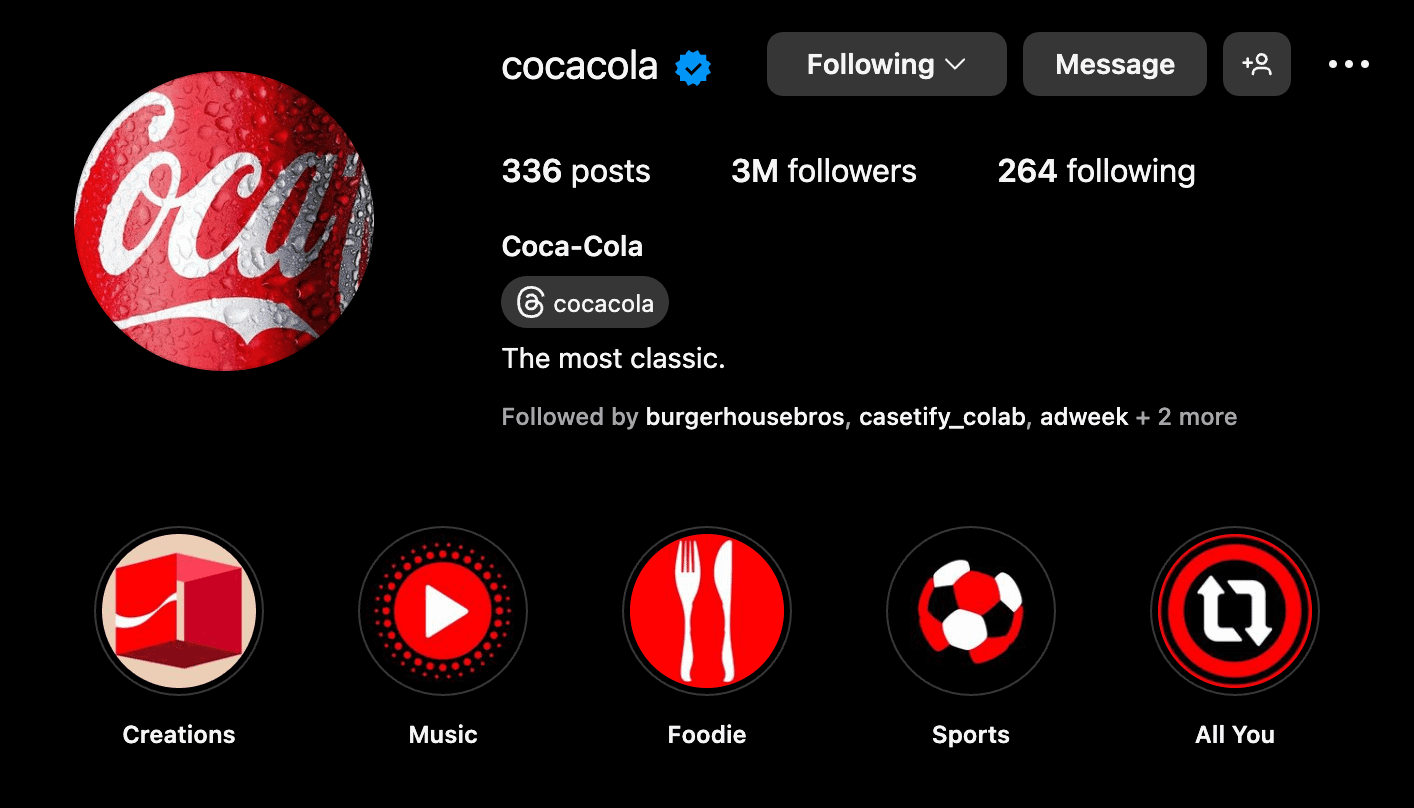
2. Establish a Clear and Unique Brand Voice
Having the same tone, style, and language in your social media posts creates a voice that communicates your brand values, mission, and culture.
Again, consistency is paramount. Don’t confuse your audience by shifting between a formal and an informal voice.
Also, make sure it’s aligned with what your audience expects.
B2B brands, for example, should adopt a more professional and authoritative tone, focusing on industry insights and data-driven content. B2C brands, on the other hand, can often afford to be more casual and relatable, engaging with their audience through storytelling, humor, and everyday language.
Wendy’s is a great example of the latter, as their cheeky humor and throwing shade at their competitors has become a hallmark of their brand identity, resonating with their younger, social media-savvy audience.
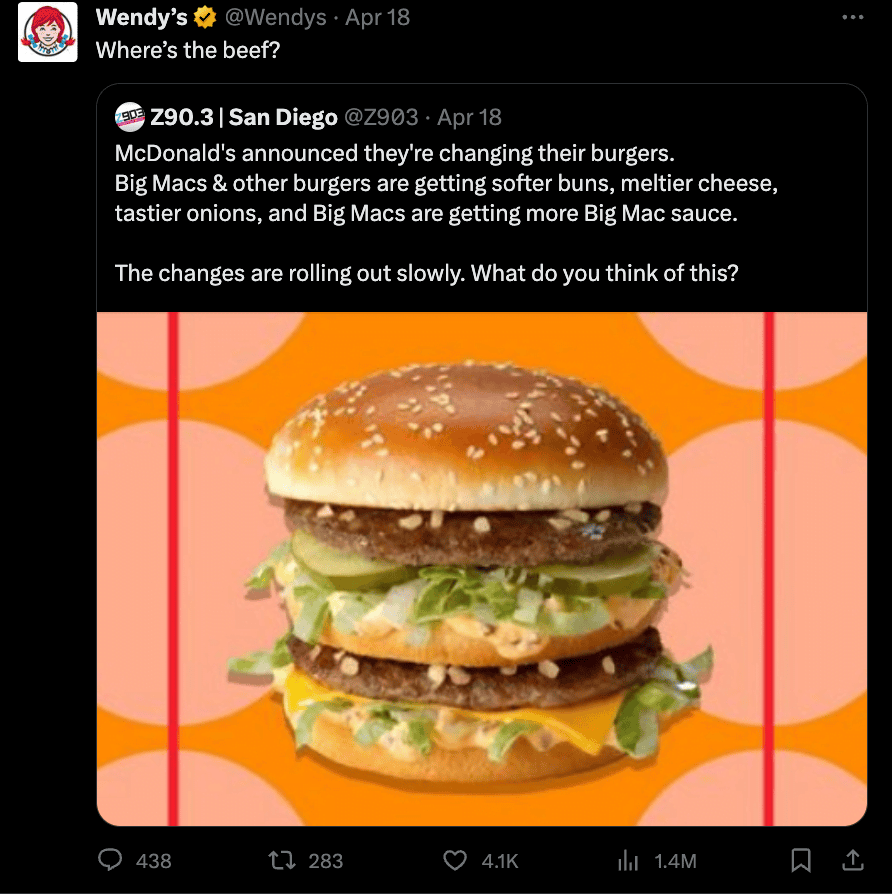
3. Deliver a Coherent and Relevant Brand Message
Leverage the same themes, topics, and goals on your social media content, as that’s how you can create a message that informs, educates, entertains, and inspires your audience.
Take a cue from Nike and their uplifting “Just Do It” slogan plastered across all their channels and the same inspirational stories and motivational quotes they share. This way, the brand creates a message that empowers its audience and reinforces the brand values.
4. Build Trust and Loyalty among Your Audience
Provide a consistent and reliable brand experience on your social media accounts. This will allow you to create a sense of familiarity and confidence among your audience.
For example, Apple is famous for its superior-quality products and customer service, which is reflected in its social media presence through a focus on product innovation and user-generated content. By consistently showcasing these elements, Apple reinforces its brand promise, fostering trust and loyalty among its customers.
5. Customize Content for Each Channel
While cohesion across your social media accounts matters, it doesn’t mean you should post the same content on every platform.
Each social media channel has its own features, audience, and best practices, and you should customize your content accordingly.
Going understands this so that their Facebook and Instagram posts are reserved for sharing practical travel tips. On the other hand, their TikTok is packed with funny yet relatable clips and memes.
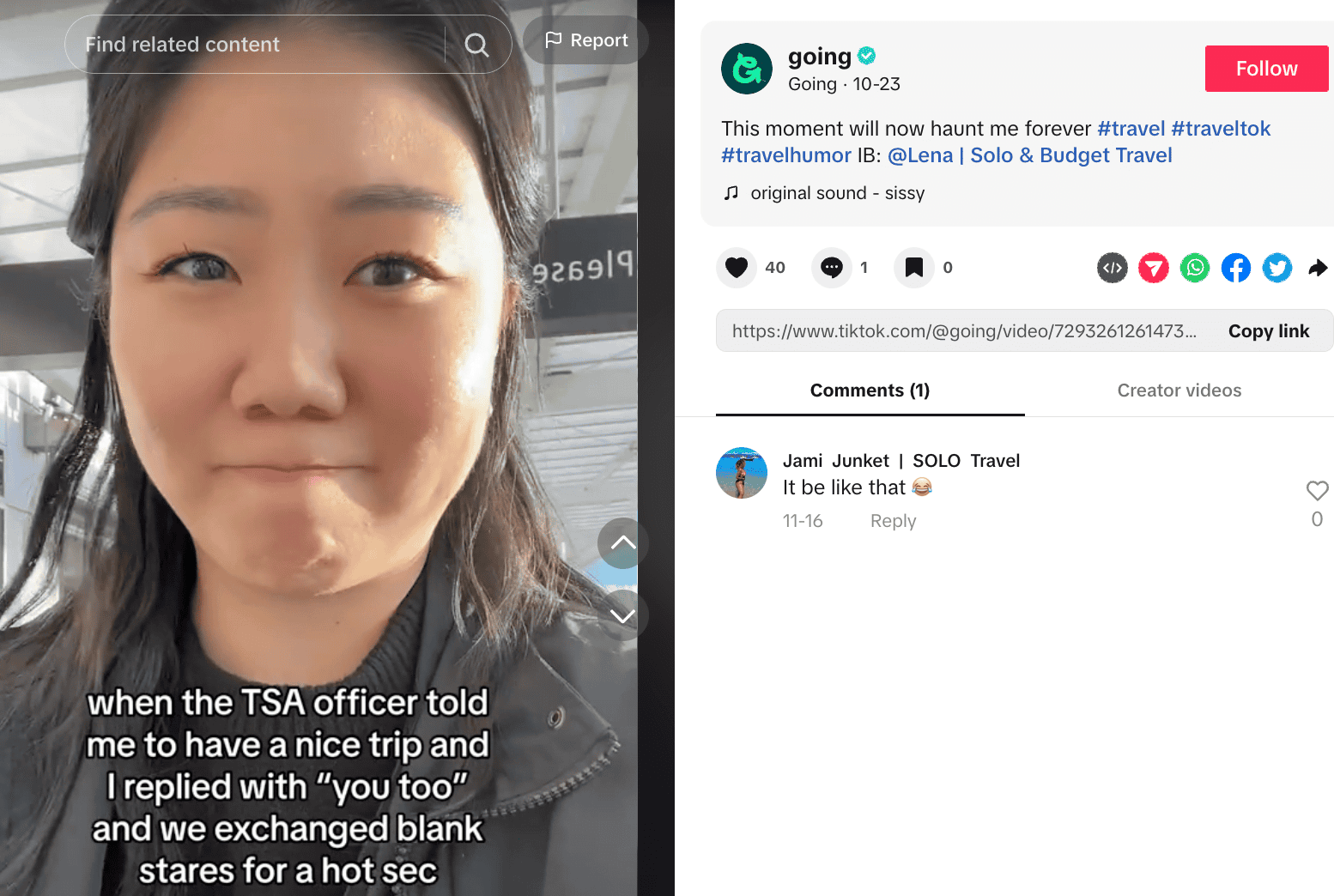
Source: TikTok
Double up on Social Proof
Social proof is a powerful way to boost engagement and trust on social media. Not only does it serve as an endorsement of your brand, but it also encourages people to engage with your content and products.
User-generated content such as reviews, testimonials, and case studies are effective forms of social proof that demonstrate the value and reliability of your brand, influencing potential customers through the positive experiences of others.
Here’s how you can implement it in your social media posts.
1. Leverage Facebook Reviews
You probably already have customer reviews on your website and third-party resources. Some social media platforms like Facebook also allow this type of social proof. This is a great opportunity to collect and display customer feedback on one of the most popular and influential social media channels.
When your potential clients are already on your Facebook Page, don’t make them navigate away from it in search of reviews.
For example, Pamoja Safaris, a travel agency specializing in custom safari and trekking tours in Tanzania, displays detailed reviews and recommendations from their happy customers. An average rating of 5 stars serves as a seal of approval and helps the company attract and convince potential travelers that they will get a top-notch experience.
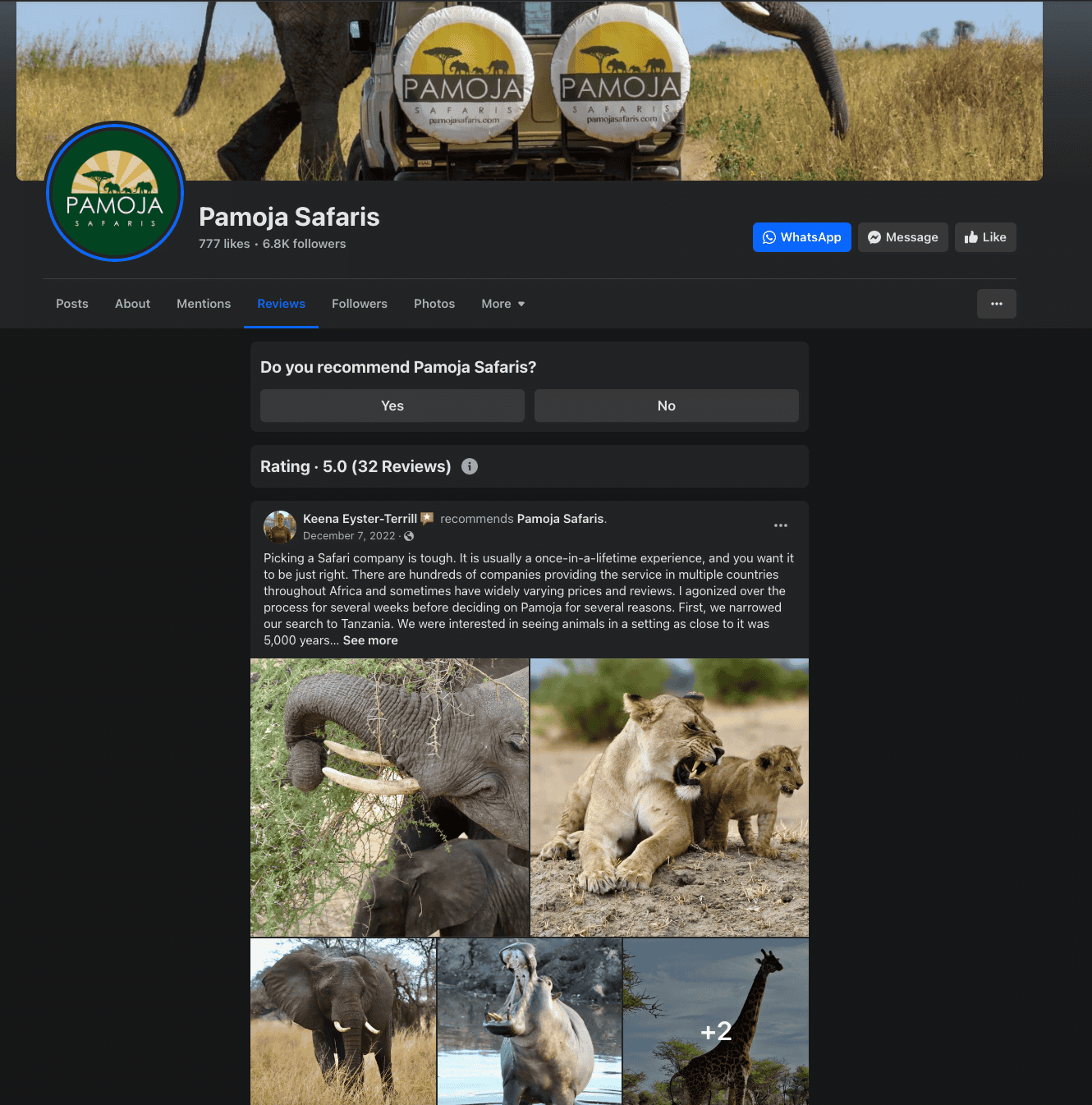
Source: Facebook
2. Make the Most of UGC
Another way to benefit from social proof is to encourage and collect user-generated content (UGC), such as photos, videos, stories, or testimonials.
By providing authenticity and relatability, UGC helps you increase your brand awareness, engagement, and credibility.
For example, Asos started a UGC campaign called #AsSeenOnMe, encouraging customers to share their styles and outfits wearing the brand’s products. Almost ten years later, the campaign is still going strong, with real customer videos and photos making up a great deal of Asos’ Instagram content.
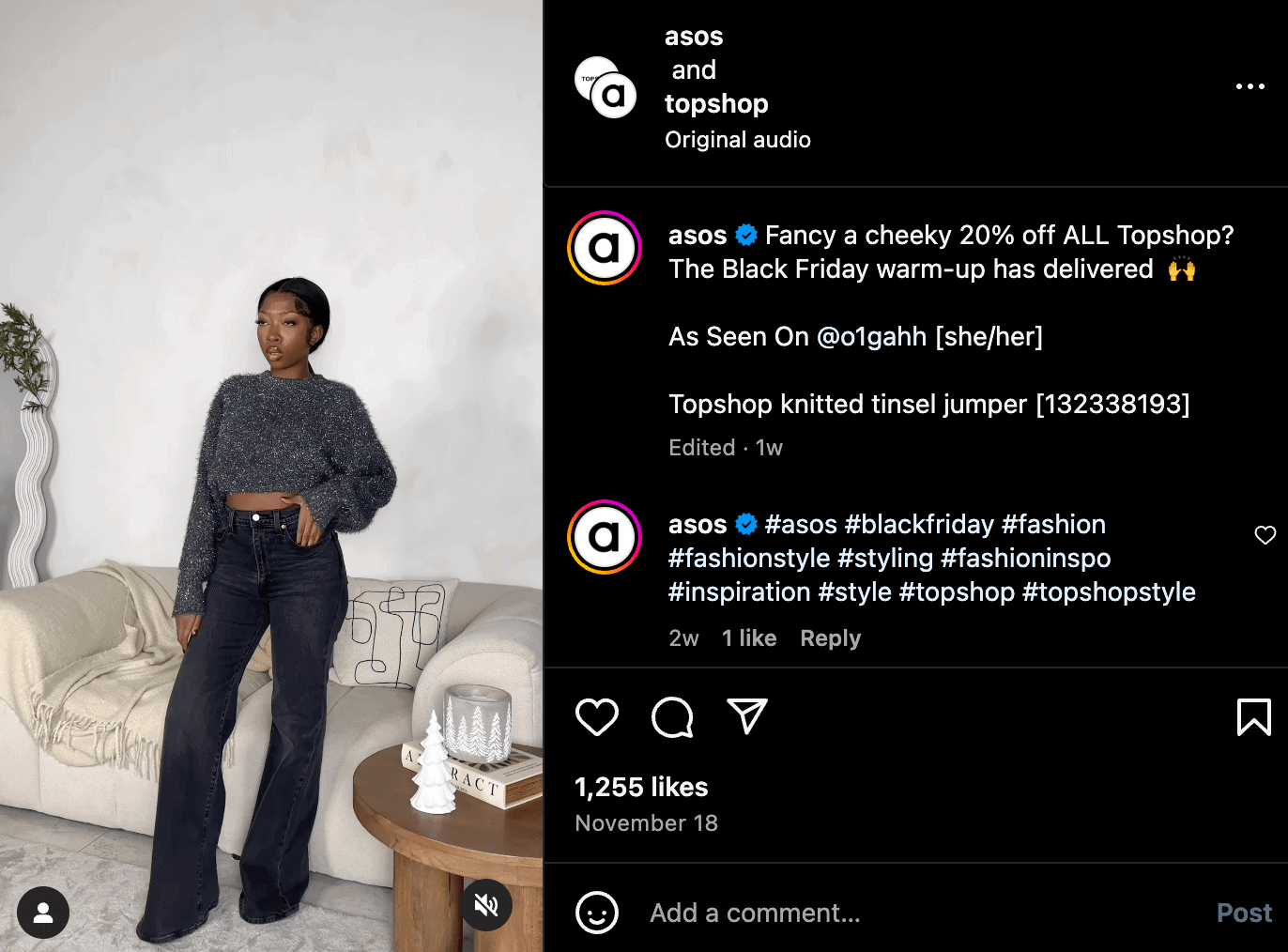
Source: Instagram
3. Create Social Media Content from Customer Feedback
Finally, you can use customer feedback to create your own social media content.
By repurposing customer reviews, questions, accolades, and comments, you can get authentic material for blog posts, Q&As, and even knowledge-based articles, thus creating impactful content and saving time.
It’s also a good idea to use customer feedback to create social media posts that highlight positive reviews, address common questions, or share customer stories.
WHOOP builds credibility by reposting their happy customers’ comments, quotes, and testimonials on their Instagram. This tactic also allows the brand to start conversations and connect with its community on a more meaningful level.
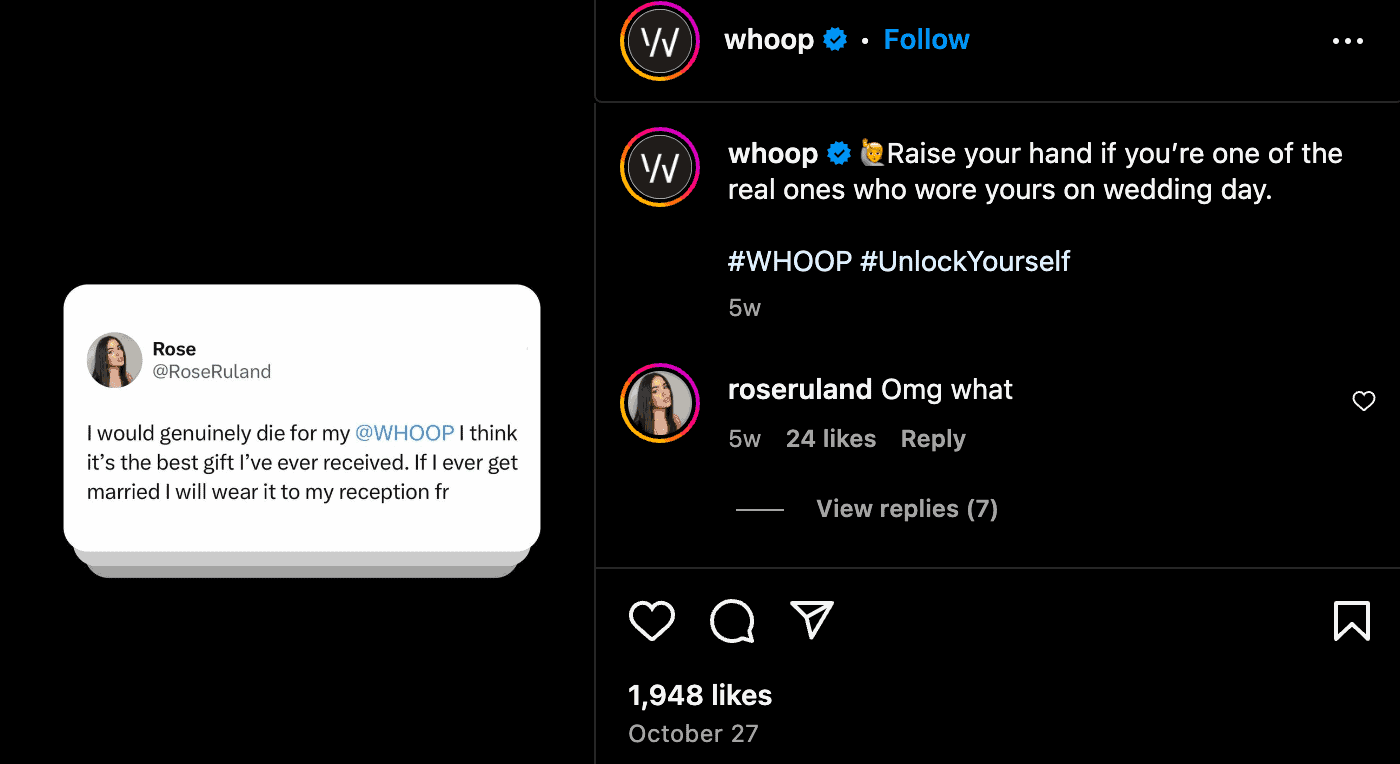
Source: Instagram
Offer Public Customer Support
According to stats, 94% of consumers are more likely to make another purchase after a positive experience with a brand. What this means is that you should amplify your customer support and service and offer it across all your channels.
In other words, if you want to delight your audience, it’s essential to respond to customer inquiries, complaints, or compliments on your social media platforms. Twitter is a particularly suitable medium for customer service, and many brands use it as an extension of their traditional support channels.
Offering public customer support can help you to:
- Show your responsiveness and transparency.
Show your audience that you care about their feedback and are willing to help them. This can also demonstrate your honesty and openness, as you are not hiding or ignoring any negative feedback but rather addressing it publicly and professionally.
- Increase your brand awareness and reputation.
By providing public customer support on your social media platforms, you can also increase your visibility and reputation, as your responses can be seen by other users who might be interested in your brand.
- Create customer loyalty and retention.
Brands that insist on offering public customer support on their social media platforms create a positive customer experience and satisfaction, which can lead to customer loyalty and retention.
There are several best practices to follow when offering public customer support on your social media platforms, such as:
1. Monitor Your Social Media Mentions and Messages
You should use social listening tools to keep track of what your customers are saying about your brand on your social media platforms and respond to them promptly and in a friendly manner.
2. Use a Friendly and Human Tone
Avoid sounding scripted and robotic when responding to your customers on your social media platforms. Include emojis, gifs, or memes to add some personality and humor to your responses.
3. Provide Helpful and Accurate Information
You should provide helpful, accurate, and detailed information when responding to your customers. Giving vague or misleading answers will only do you a disservice and tarnish your reputation. Use links, screenshots, or videos to make your responses more informative and educational.
4. Apologize and Empathize
Sometimes, customers will be angry and disgruntled. Instead of arguing with them or, even worse, deleting their comments, it’s critical to apologize and empathize in your responses. You should acknowledge their feelings and concerns, express your regret and sympathy, and offer a solution or compensation to make them feel better.
Zappos is famous for its timely customer service on Twitter. The brand responds to each and every question and comment, usually inviting customers to take the conversation to DMs for further assistance. By leaving nothing to chance, Zappos has become one of the most beloved shoe and apparel retailers, and customers have no concerns over their online orders since they’re constantly reassured that the brand will resolve any issue quickly.
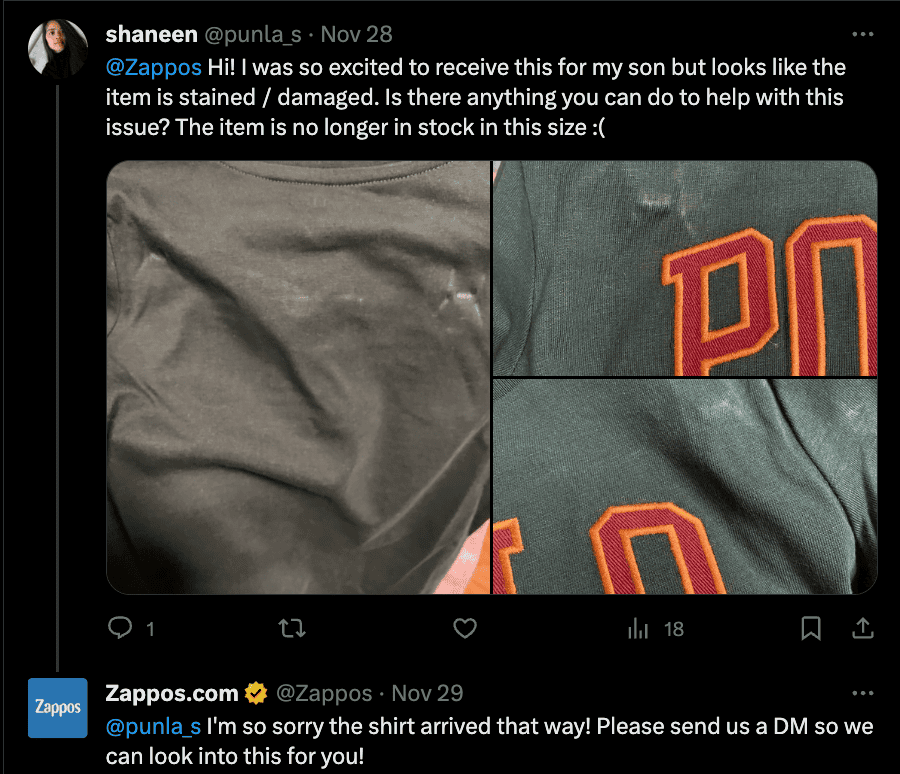
Source: Twitter
Publish Exceptionally Helpful Content
Although the entertainment aspect is very important, Facebook, Instagram, and TikTok are also powerful platforms for educating and informing your audience.
Publishing helpful content on your social media channels will also allow you to showcase your expertise and prove that you know what you are talking about. This way, you can build your brand credibility and authority and make your audience trust and respect you more.
Don’t forget that many of your leads come to your social media first in search of product information. It’s crucial to cater to their needs on these channels, too.
So, make sure to provide them with valuable and relevant content they can use to learn something new or solve their pain points.
Even though social media isn’t suitable for long-form content such as blog posts or lengthy guides, you can share educational and data-driven posts such as how-to videos, tutorials, colorful infographics, or live streams. In other words, visually-oriented content lends itself perfectly to such mediums as it’s easy to follow and digest.
The Seller Candy YouTube is a perfect example of implementing this strategy. It’s packed with videos providing tips and hacks for growing a successful Amazon business and addressing the needs of sellers of all levels of expertise.

Source: YouTube
Don’t Overlook the Importance of LinkedIn
LinkedIn is not just a platform for job seekers and professionals. It’s also a great place for brands to appear super professional and trustworthy and to connect with their target audience, potential customers, and industry peers. Stats say LinkedIn is the most trusted social media platform. Moreover, LinkedIn is the top-rated social network for lead generation, with 62% of B2B marketers saying the platform produces leads for them.
Therefore, if you want to build your brand credibility on social media, you should make LinkedIn your priority. Here are some best practices to implement:
- Optimize your LinkedIn page.
Your LinkedIn Page should reflect your brand identity, values, and personality. To make the most of your LinkedIn Page, you should complete all the Page details, such as your logo, cover image, overview, organization info, and call-to-action button. You should also use relevant keywords and hashtags to help your Page rank higher in search results and reach more people.
- Pay attention to detail.
Make sure you have a clear and catchy headline that summarizes what your company does and what distinguishes it from competitors. It’s important your logo and cover image are professionally designed and optimized for LinkedIn size requirements.
- Participate in conversations.
To improve your visibility and establish yourself as an industry leader, engage in conversations with your connections and join groups relevant to your niche where you’ll find like-minded professionals and potential customers. Sharing your expertise and offering insights will help you build relationships that can be beneficial for your business growth.
Vivion’s LinkedIn page is a great example of all this. Their logo and cover image are memorable, while the tagline summarizes what the company’s main products are. The brand also regularly shares updates and posts about topics relevant to its audience.
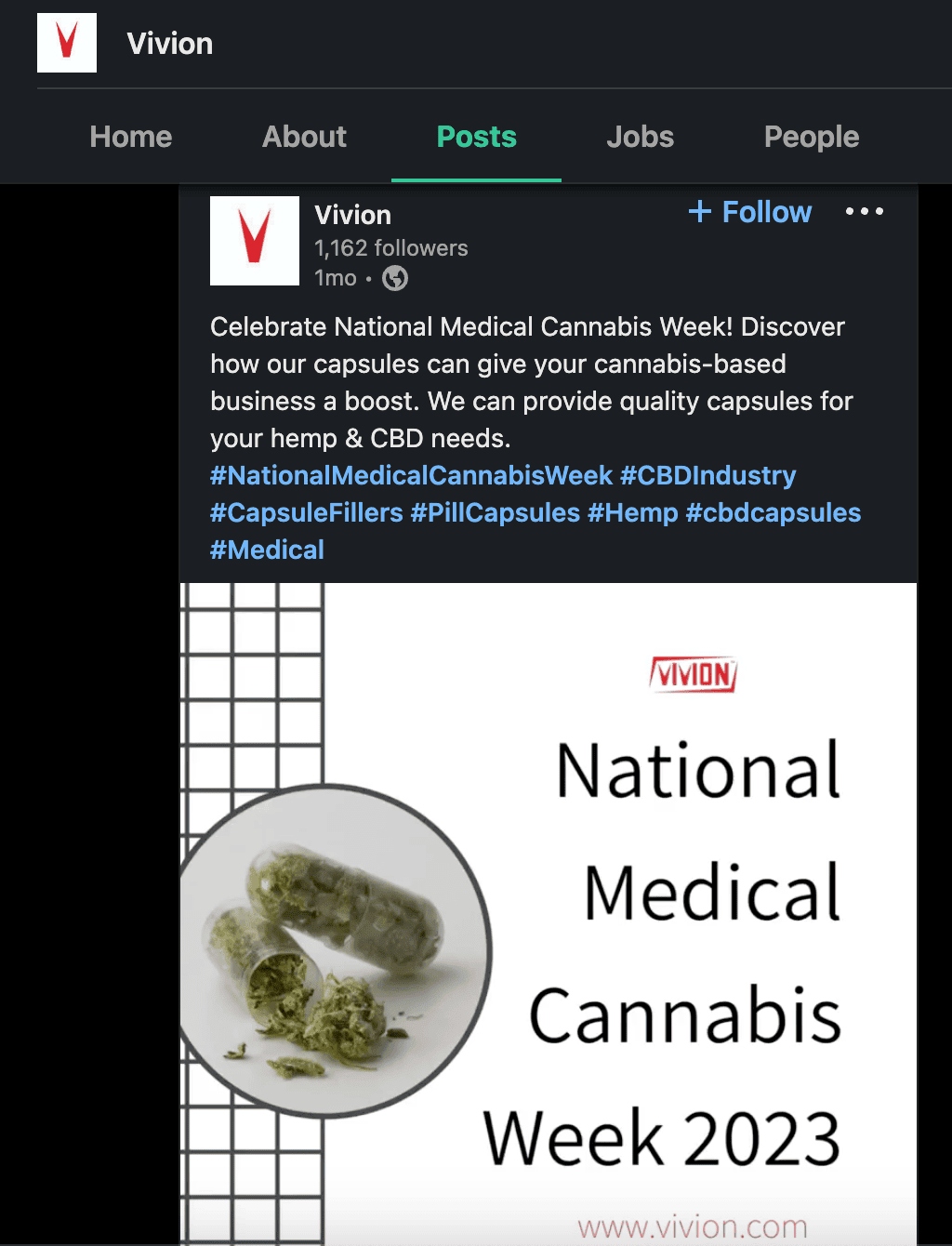
Source: LinkedIn
Publish Content That Presents Your Product
It’s a good idea to publish posts presenting your product and showing how it works. This type of content helps potential customers see what they can do with your product while also instructing the existing customers on how to get the most out of it.
Video is a particularly effective format for this purpose, as it’s more engaging and persuasive than text. One of the best ways to present your product is to create videos that showcase its features, benefits, and use cases.
Here are some video types you can use:
- Demo videos demonstrate how your product works, how to set it up, and how to use it. They can also highlight the main problems that your product solves and the unique value proposition that it offers.
- Testimonial videos — enlisting your happy customers to share their positive experiences with your product and how it helped them achieve their goals. They can also address common objections or questions that potential customers might have and provide social proof that your product delivers on its promises. Such content provides additional context since potential customers can find out how your product fits into real-life scenarios and how it worked for other people with similar pain points.
- Tutorial videos teach your customers how to use your product effectively and how to get the most out of it. They can also provide tips, tricks, and best practices that can enhance your customers’ satisfaction and loyalty.
Among Lanteria’s YouTube videos are those that explain how different features of this HR platform work and how users can benefit from it. These videos are concise so that customers can quickly understand how they can maximize their processes by implementing Lanteria.
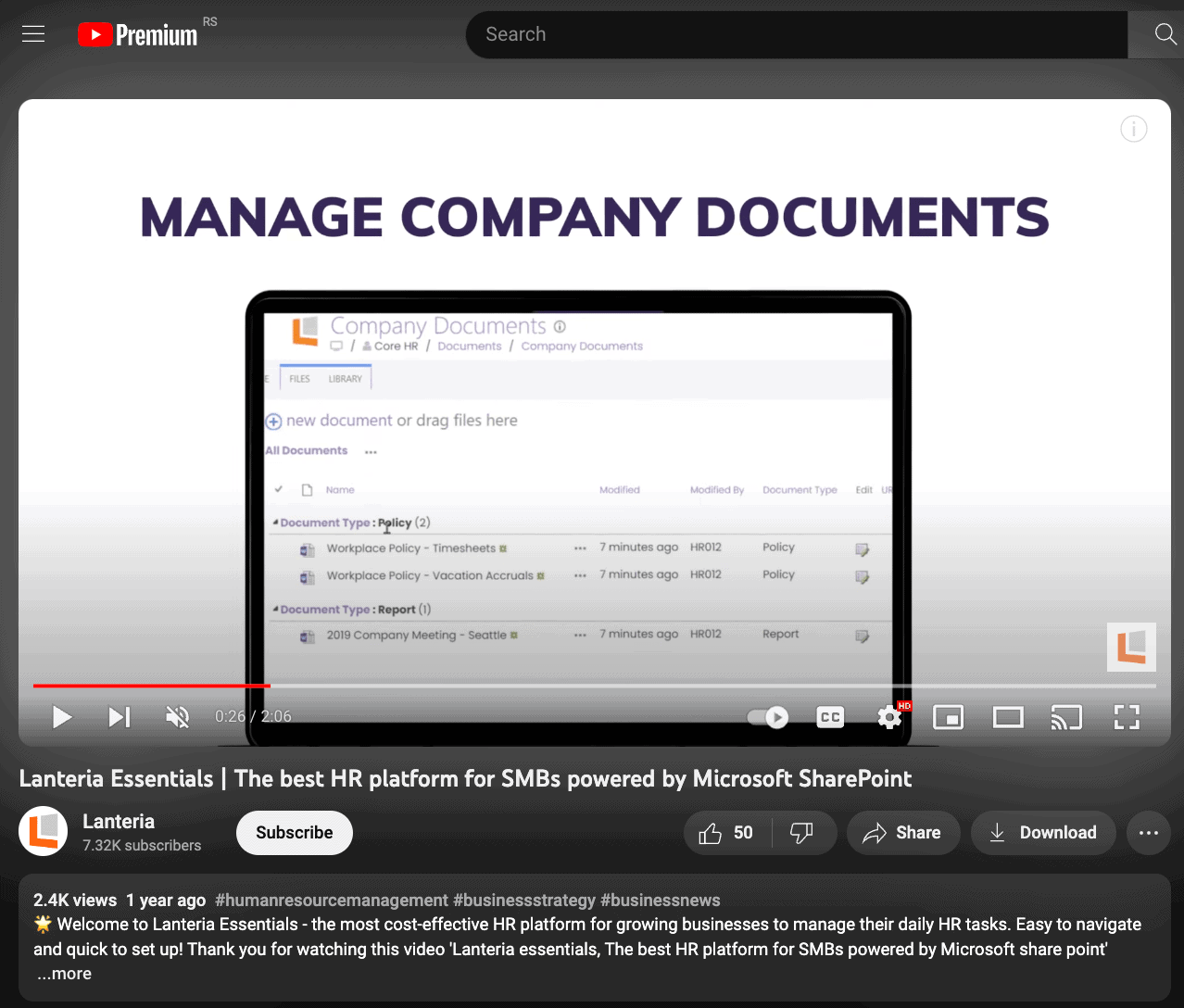
Source: YouTube
In Closing
Leveraging social media for your brand is about striking the right balance between sharing helpful content and showcasing your products or services. The trick is to understand and utilize the unique strengths of each channel so that you can build brand credibility, foster meaningful relationships with your audience, and demonstrate the real-world value of what you offer. The tips we discussed can help you achieve this more easily.

